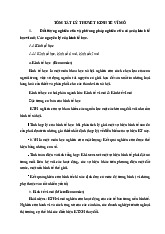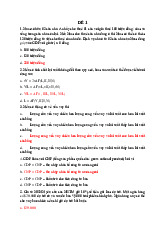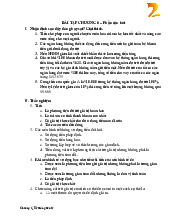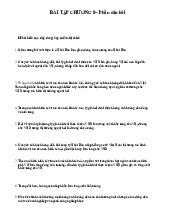
















Preview text:
lOMoARcPSD| 49153326
MICROECONOMICS MID-TERM REVISION
ÔN TẬP VI MÔ GIỮA KÌ
CHƯƠNG 1 TỔNG QUAN VỀ KINH TẾ HỌC (INTRODUCTION TO ECONOMICS)
• Vấn đề kinh tế (khan hiếm)? Các chủ thể trong nền kinh tế, loại thị trường, câu hỏi
trong nền kinh tế? (Economic problem? Scarcity? Economic agents, types of
markets, three basic questions?)
- Scarcity: the condition in which our wants are greater than the resources available to satisfy those wants - Three economic agents: Government Firm Household/Individual - Three types of markets:
Markets for goods and services
Markets for factors of production Financial markets - Three questions What to produce? How to produce ? For whom to produce?
• Kinh tế học? (Economics?) Economics is the study of how society manages its scarce resources
• Kinh tế vĩ mô? Ví dụ? (Macroeconomics?) Macroeconomics is the study of
economywide phenomena, including inflation, unemployment, and economic growth.
• Kinh tế vi mô? Ví dụ? (Microeconomics?)
Microeconomics is the study of how buyers and sellers make decisions and how they
interact in market.( Demand, supply and equilibrium, Production theory, Costs of
production, Labor economics)
• Kinh tế học chuẩn tắc, kinh tế học thực chứng? (Positive economics, normative economics?)
Positive analysis: (Kinh tế học thực chứng)
- Factual analysis, the analysis of “What is”.
- There are no personal judgement involved.
- Positive statement can be tested, can be proven or disproven.
Normative analysis: (Kinh tế học chuẩn tắc)
- Opinion-based analysis, the analysis of “What should be”. lOMoARcPSD| 49153326
- Involves personal judgements or ideals.
- Normative statement cannot be proven or disproven.
• 3 cơ chế kinh tế? Thuyết “bàn tay vô hình” của Adam Smith (Three economic
systems? Adam Smith’s Invisible Hand? -Three economic systems: Command economy (1) Market economy (2) Mixed economy
Adam Smith's Invisible Hand
• Famous insight by Adam Smith in The Wealth of Nations (1776):
Each of these households and firms acts as if “led by an invisible hand” to promote general economic well-being.
• The invisible hand works through the price system:
- The interaction of buyers and sellers determines prices.
- Each price reflects the good’s value to buyers and the cost of producing the good.
- Prices guide self-interested households and firms to make decisions that, in many cases,
maximize society’s economic well-being. •
Mô hình kinh tế? Trình bày các thành phần của mô hình? (Economic model?
Components of an economic model?)
Economic model: a simplified version of reality that allows us to observe, understand,
and make predictions about economic behavior. Qualitative method Quantitative method •
Tại sao các nhà kinh tế thường mâu thuẫn khi tranh luận? (Why do
economists disagree?) Differences in Scientific Judgments, Differences
in Values, Perception versus Reality •
Khi nào nhà kinh tế là nhà khoa học, khi nào là nhà làm chính sách?
(When do economists play the role as scientists? As policy advisors?)
- Scientists: explain the world
- Policy advisors: improve the world •
10 nguyên lý kinh tế? Lấy ví dụ cụ thể? (What are ten principles of Economics?)
Principle 1: People Face Trade-offs
“There is no such thing as a free lunch!”
To get one thing, we usually have to give up another thing lOMoARcPSD| 49153326 Efficiency v. Equity •
Efficiency means society gets the most that it can from its scarce resources. •
Equity means the benefits of those resources are distributed fairly among the members of society. EX: Guns v. butter Food v. clothing Leisure time v. work Efficiency v. equity
Principle 2: The Cost of Something Is What You Give Up to Get It
Decisions require comparing costs and benefits of alternatives. •
Whether to go to college or to work? •
Whether to study or go out on a date? •
Whether to go to class or sleep in?
The opportunity cost of an item is what you give up to obtain that item. •
EX: Basketball star LeBron James understands opportunity costs and
incentives. He chose to skip college and go straight from high school to
the pros where he earns millions of dollars.
Principle 3: Rational People Think at the Margin
Marginal changes are small, incremental adjustments to an existing plan of action.
People make decisions by comparing costs and benefits at the margin.
Principle 4: People Respond to Incentives •
Marginal changes in costs or benefits motivate people to respond. •
The decision to choose one alternative over another occurs when that
alternative’s marginal benefits exceed its marginal costs!
Principle 5: Trade Can Make Everyone Better Off
Principle 6: Markets Are Usually a Good Way to Organize Economic Activity
Principle 7: Governments Can Sometimes Improve Market Outcomes
Principle 8: A Country’s Standard of Living Depends on Its Ability to Produce Goods and Services
Principle 9: Prices Rise When the Government Prints Too Much Money
Principle 10: Society Faces a Short-Run Trade-off between Inflation and Unemployment lOMoARcPSD| 49153326
CHƯƠNG 2 LÝ THUYẾT CUNG – CẦU (DEMAND AND SUPPLY) Cầu (Demand): Cung (Supply) lOMoARcPSD| 49153326 - Phương trình (Function) - Phương trình (Function) -
Hệ số góc luật cầu (Slope -> Law of - Hệ số góc luật cung (Slope -> Law demand) of supply) -
Biểu cầu (Demand schedule) - Biểu cung (Supply schedule) -
Cầu cá nhân và cầu thị trường -
Cung cá nhân và cung thị trường
(Individual demand vs market demand)
(Individual supply vs market supply) -
Phân biệt lượng cầu vs cầu (Quantity -
Phân biệt lượng cung vs cung demanded vs Demand)
(Quantity supplied vs Supply) o Di chuyển trên đường cầu
o Di chuyển trên đường cung (Movement along demand curve)
(Movement along supply curve) o Dịch chuyển đường cầu (Shift in o Dịch
chuyển đường cung (Shift in demand curve) supply curve)
o Các yếu tố tác động đến cầu ngoài
o Các yếu tố tác động đến cung ngoài
giá (Non-price determinants of
giá (Non-price determinants of demand) supply)
CÂN BẰNG CUNG CẦU (MARKET EQUILIBRIUM) -
Điều kiện cân bằng thị trường: Thị trường là quá trình giao dịch giữa bên mua và
bên bán để xác định giá giao dịch và lượng giao dịch (Market equilibrium condition) -
Trạng thái dư thừa; thiếu hụt (Surplus, shortage) -
Thay đổi điểm cân bằng thị trường (Change in market equilibrium) -
Kiểm soát giá của chính phủ: Giá trần; giá sàn (Price controls of government: Price ceiling, price floor)
Cầu (Demand): The amount of a good or
Cung (Supply) service that buyers are willing to buy and -
Phương trình (Function) able to
buy at all possible prices during a → Qs = cP + d (c>0) certain time period, ceteris paribus -
Phương trình (Function): -
Hệ số góc luật cung (Slope ->
→ QD = aP + b (a < 0) Law of supply) → Law of supply: -
Hệ số góc luật cầu (Slope -> Law • Other things equal of demand)
• When the price of a good rises, the → Law of demand:
quantity supplied of that good also
• Other things equal (=other things stay rises lOMoARcPSD| 49153326 the same)
• When the price falls, the quantity
• When the price of a good rises, the
supplied falls as well quantity demanded of that good falls. -
Biểu cung (Supply schedule)
• When the price falls, the quantity → Supply schedule a table that shows the demanded rises
relationship between the price of a good -
Biểu cầu (Demand schedule) and the quantity supplied
→ Demand schedule a table that shows the
Occurs when a non-price determinant
relationship between the price of a good and of demand changes the quantity demanded
D Curve shifts right: increase in -
Cầu cá nhân và cầu thị trường demand
(Individual demand vs market
D Curve shifts left: decrease in demand) demand
→ The quantity demanded in the market is -
Các yếu tố tác động đến cầu ngoài
the sum of the quantities demanded by all
giá (Non-price determinants of buyers at each price. demand) -
Phân biệt lượng cầu vs cầu (Quantity • Income (I): demanded vs Demand) I ↑ → QD↑
• Demand: The amount of a good or I ↓ → QD↓
service that buyers are willing to buy → Normal
and able to buy at all possible prices goods I
during a certain time period, ceteris ↓ → QD↑ paribus. Demand is the whole I ↑ → QD↓ demand curve. -
Cung cá nhân và cung thị trường
• Quantity demanded (QD):The amount
(Individual supply vs market
of a good or service that buyers are supply)
willing to buy and able to buy at a
→ The quantity supplied in the market is
price during a certain time period,
the sum of the quantities supplied by all
ceteris paribus. Quantity demanded is sellers at each price
a single point on the demand curve. -
Phân biệt lượng cung vs cung
(Quantity supplied vs Supply)
-Di chuyển trên đường cầu
• Supply (S): The quantity of goods (Movement along demand
and services that sellers is willing curve)
to sell and able to sell at all
→ Change in the quantity demand
possible prices during a certain Occurs when P changes
time period, ceteris paribus. Supply -
Dịch chuyển đường cầu (Shift in is the whole supply curve demand curve)
• Quantity supplied (QS): The → Change in demand
quantity of goods and services that lOMoARcPSD| 49153326
seller is willing to sell and able to sell Occurs when n a non-price
at a price during a certain time period, determinant of supply changes
ceteris paribus. Quantity supply is
D Curve shifts right: increase in supply
single point on the supply curve
D Curve shifts left: decrease in suply
- Di chuyển trên đường cung
- Các yếu tố tác động đến
(Movement along supply curve)
cung ngoài giá (Non-price
→ Change in n the quantity supplied
determinants of supply) • Occurs when P changes
Technology (T): determines how -
Dịch chuyển đường cung (Shift in much inputs are required to supply curve) produce a unit of output → Change in suppy • lOMoARcPSD| 49153326 → Inferior goods
• Tastes (J): Change in tastes: changes the demand
• Expectations (E): about the future Expect an increase in income
Leads to an increase in today’s demand Expect higher prices
Leads to an increase in today’s demand
• Number of buyers (N): Market demand increases • Prices of related goods:
Substitutes, two goods: An increase in the
price of one , leads to an increase in the demand for the other
Complements, two goods: An increase in
the price of one, leads to a decrease in the demand for the other.
CÂN BẰNG CUNG CẦU (MARKET EQUILIBRIUM)
- Điều kiện cân bằng thị trường: Thị trường là quá trình giao dịch giữa bên
mua và bên bán để xác định giá giao dịch và lượng giao dịch (Market equilibrium condition)
→ Market Equilibrium (E): QD = QS= QE
- Trạng thái dư thừa; thiếu hụt (Surplus, shortage) Shortage: P1 < PE Qd > Qs
Price tends to rise and below equilibrium price Surplus: P2 > PE Qd < Qs
Price tends to fall and above equilibrium price.
- Thay đổi điểm cân bằng thị trường (Change in market equilibrium)
- Kiểm soát giá của chính phủ: Giá trần; giá sàn (Price controls of
government: Price ceiling, price floor) Price ceiling
The highest price allowed in the market, for the sake of buyer lOMoARcPSD| 49153326 What happens? : shortage
Below equilibrium price Price floor:
The lowest price allowed in the market, for the sake of seller What happens?: surplus Above equilibrium price.
CHƯƠNG 3 ĐỘ CO GIÃN (ELASTICITY OF DEMAND)
Độ co giãn của cầu theo giá (Price elasticity of demand) - o Khái niệm (Definition)
ED = percentage change in quantity demanded over percentage change in variable x - - E = %ΔQ / %Δx D (Q = QD) -
Elasticity of demand measures how much the quantity demanded of a good responds to a
change in one of its determinants.
o Công thức và cách tính (Formula) E = %ΔQ / %Δx D (Q = QD) o
Phân loại và các trường hợp thực tế (Classifications and determinants) Classifications: Ed > 1: demand is elastic
- A price decrease → TR increases
Ed < 1: demand is inelastic
- A price increase → TR increases
Ed = 1: demand is unit elastic
- When P changes → TR remains constant (TR max)
Determinants of Price Elasticity of Demand Inelastic (Ed<1) -Necessities -Few close substitutes
-A small portion of your income you give up to buy st -In the short run Elastic (Ed>1) lOMoARcPSD| 49153326 -Luxuries -Many close substitutes
-A large portion of your income you give up to buy st -Sp qua mua vu
o Mối quan hệ giữa Ed và TR (Relationship between Ed and TR) o Hai
trường hợp đặc biệt của Ed (Two extreme cases of Ed) TH1: Ed=0 Perfectly inelastic demand
D curve: vertical
Consumers’ price sensitivity:none Elasticity:0 TH2: Ed= infinity oo Perfectly elastic demand
D curve: horizontal
Consumers’ price sensitivit: extreme
Độ co giãn của cầu theo thu nhập (Income elasticity of demand) -
Khái niệm: Percentage change in quantity demanded over percentage change in income
How much the quantity demanded of a good responds to a change in consumers’ income
o Công thức Ei= %ΔQ / %ΔI= (ΔQ / ΔI).(I/Q) • Phân loại
Ei < 0 (negative): inferior goods
Ei > 0 (positive): normal goods
+ 0 < Ei < 1: necessity + Ei > 1: luxury o
Độ co giãn chéo của cầu (Cross-price elasticity of demand) -
Khái niệm: How much the quantity demanded of a good responds to a change in consumers’ income
Percentage change in quantity demanded over percentage change in income
o Công thức : Ex,y= %ΔQx / %ΔPy= (ΔQx / ΔPy).(Py/Qx) o Phân loại lOMoARcPSD| 49153326
Ei < 0 (negative): inferior goods
Ei > 0 (positive): normal goods
+ 0 < Ei < 1: necessity + Ei > 1: luxury
CHƯƠNG 4 THỊ TRƯỜNG VÀ PHÚC LỢI (MARKET AND WELFARE) Thị trường? -
A market is a group of buyers and sellers of a particular good or service CS và PS? -
Consumer surplus is the difference between what consumers are willing to pay and what they actually pay.
Consumer surplus can be found in the area above the price and below the demand curve.
Consumer surplus can be calculated using the formula for the area of a triangle.
• Producer surplus is the difference between the price received and the seller's cost.
Producers surplus can be found in the area below the price and above the supply curve.
Producer surplus can be calculated using the formula for the area of a triangle.
Thuế của chính phủ: ảnh hưởng đến CS và PS; doanh thu thuế của chính phủ và
- phần tổn thất vô ích của xã hội; người tiêu dùng chịu thuế; nhà sản xuất chịu thuế.
(Tax levied on buyers/sellers: CS, PS, tax revenue of government, deadweight loss; the
amount of tax that buyers have to pay, the amount of tax that sellers have to pay)
CHƯƠNG 5 QUYẾT ĐỊNH LỰA CHỌN TIÊU DÙNG (THE THEORY OF CONSUMER CHOICE)
Khái niệm: U; TU; MU (qui luật lợi ích cận biên giảm dần/quy luật lợi ích tới hạn) -
(Utility, Total Utility, Marginal Utility, Principle of Diminishing Marginal Utility) • Utility (U)
the satisfaction or pleasure that a consumer gets from the consumption of a good or service
• Total utility (TU) the total satisfaction or pleasure that a consumer gets from the
consumption of goods and services
• Marginal Utility (MU)
measures additional satisfaction obtained from consuming 1 additional unit of goods or services.
the change in total utility due to a one-unit increase in the quantity of a good or service. lOMoARcPSD| 49153326 MU h= Q
Principle of Diminishing Marginal Utility:
The marginal utility of a good or service decreases as the quantity of the good
increases, ceteris paribus. In other words, total utility increases more and more slowly as
the quantity consumed increases.
Đường đồng ích: khái niệm, hệ số góc (MRS); đặc điểm. (Indifference -
curve: definition, slope (MRS), properties) o Shows consumption bundles
that give the consumer the same level of satisfaction
o Combinations of goods on the same curve, Same satisfaction
1. Higher indifference curves are preferred to lower ones.
2. Indifference curves are downward-sloping
3. Indifference curves cannot cross
4. Indifference curves are bowed inward MRS = slope of indifference curve = - Mux/MUY
the rate at which a consumer is willing to trade one good for another
MRS falls as you move down along an indifference curve.
MRS is the amount of Y consumer would substitute for another X.
Đường ngân sách: khái niệm, hệ số góc; 3 trường hợp thay đổi (Budget line: -
definition, slope, 3 types of change)
Budget constraint: shows the possible combinations of different goods
that consumer can buy given her income and the prices of the goods. I = PX.X + PY.Y
+ Slope of budget line: (y)’x= -Px/Py
TH1: PX, PY = const, I changes I decreases: I increases: lOMoARcPSD| 49153326
TH2: I, PY = const, PX changes PX decreases: PX increases: TH3:I, PX = const, PY changes PY decreases: PY increases:
Budget constraint: shows the possible combinations of different goods that
consumer can buy given her income and the prices of the goods. - lOMoARcPSD| 49153326
Điều kiện tối đa hóa lợi ích khi lựa chọn tiêu dùng (Condition for maximizing utility/Optimization)
Exercise 1: Cho sản phẩm X là sản phẩm thị trường, có biểu cầu và biểu cung như sau. ĐVT: 1000 sản phẩm.
The market for good X has the following demand and supply schedules. Unit: 1000 products Price (1000 VND) 50 70 Quantity demanded 180 120 Quantity supplied 100 200
a. Xác định giá và lượng cân bằng thị trường của hàng hóa X. Vẽ đồ thị.
b. Tính hệ số co giãn của cầu theo giá tại mức giá và lượng cân bằng. Nếu doanh nghiệp
tăng giá thì doanh thu tăng hay giảm, giải thích tại sao?
c. Tại giá thị trường P=30, tính thặng dư tiêu dùng, thặng dư sản xuất trong trường hợp
chính phủ trợ cấp phần thiếu hụt
d. Nếu chính phủ đánh thuế đơn vị t = 10 vào nhà sản xuất (thuế trực thu). Xác định:CS và PS trước thuế.
- Sau thuế tính: CS, PS, doanh thu thuế của chính phủ và tổn thất vô ích xã hội do thuế - trực thu gây ra.
a. What are the equilibrium price and quantity in the market? Drawing a graph.
b. What is the price elasticity of demand Ed at equilibrium price and quantity? An increase
in the price will cause sellers’ total revenue to increase or decrease?
c. At the market price of 30, what is consumer surplus and producer surplus if the
government deals with the shortage?
d. Assume that the government imposes a tax of 10/unit on the seller (thuế trực thu). Calculate: lOMoARcPSD| 49153326 CS and PS without tax. -
With tax: CS, PS, tax revenue and deadweight loss. - lOMoARcPSD| 49153326 lOMoARcPSD| 49153326
Exercise 2: A consumer has an income of 3,000,000 VND per month, saving 20% of the
income, and allocating the remaining income to two goods: food and entertainment, the price
of food is P(F) = 10,000 VND/unit, the price of entertainment is P(M) = 15,000 VND/unit.
Assume that the consumer has utility function: TU = 4F1/4M3/4 (F: the amount of food, M: the
amount of entertainment). How much of each good should the consumer purchase to maximize his/her utility?
Một người A có thu nhập 3.000.000 đồng, tiết kiệm 20%, phần còn lại dùng hết cho 2
hàng hóa lương thực và giải trí với giá tương ứng P(F) = 10.000 đ/đơn vị, P(M) = 15.000 đ/đơn
vị. Giả định rằng người A không bị giới hạn về thời gian và có hàm tổng lợi ích TU = 4F1/4M3/4
(F: đơn vị lương thực; M: đơn vị giải trí). Tìm F và M để tối đa hóa lợi ích?




